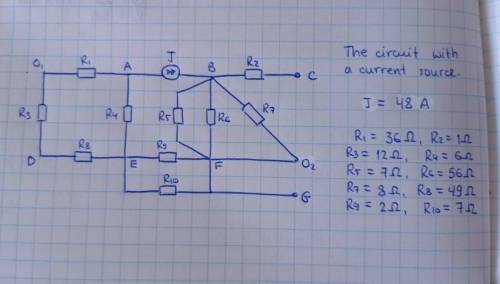Simple dc circuit
1. Determine the current, voltage, and power of each branch.
2. Determine...

Simple dc circuit
1. Determine the current, voltage, and power of each branch.
2. Determine potential at A, B, C, D, E, F, G points compare to 01 and 02 points.
3. Determine voltage between A and F; G and C.
4. Determine the absorbed and dissipated power of each element.


Answers: 3


Another question on Physics

Physics, 21.06.2019 20:50
An airplane flies eastward and always accelerates at a constant rate. at one position along its path it has a velocity of 34.3 m/s, it then flies a further distance of 40100 m and afterwards its velocity is 47.5 m/s. find the airplane\'s acceleration and calculate how much time elapses while the airplane covers those 40100 m.
Answers: 1

Physics, 22.06.2019 01:30
Use the frequency histogram to complete the following parts. ​(a) identify the class with the​ greatest, and the class with the​ least, relative frequency. ​(b) estimate the greatest and least relative frequencies. ​(c) describe any patterns with the data. female fibula lengths 30.5 31.5 32.5 33.5 34.5 35.5 36.5 37.5 38.5 39.5 0 0.05 0.1 0.15 0.2 0.25 length (in centimeters) relative frequency a histogram titled "female fibula lengths" has a horizontal axis labeled "length in centimeters" from 30.5 to 39.5 in increments of 1 and a vertical axis labeled "relative frequency" from 0 to 0.25 in increments of 0.05. the histogram contains vertical bars of width 1, where one vertical bar is centered over each of the horizontal axis tick marks. the approximate heights of the vertical bars are listed as follows, where the label is listed first and the approximate height is listed second: 30.5, 0.02; 31.5, 0.04; 32.5, 0.05; 33.5, 0.13; 34.5, 0.22; 35.5, 0.25; 36.5, 0.13; 37.5, 0.06; 38.5, 0.09; 39.5, 0.01. ​(a) the class with the greatest relative frequency is nothing to nothing centimeters. ​(type integers or decimals. do not round. use ascending​ order.)
Answers: 3

Physics, 22.06.2019 03:30
As part of an industrial process, air as an ideal gas at 10 bar, 400k expands at steady state through a valve to a pressure of 4 bar. the mass flow rate of air is 0.5 kg/s. the air then passes through a heat exchanger where it is cooled to a temperature of 295k with negligible change in pressure. the valve can be modeled as a throttling process, and kinetic and potential energy effects can be neglected. (a) for a control volume enclosing the valve and heat exchanger and enough of the local surroundings that the heat transfer occurs at the ambient temperature of 295 k, determine the rate of entropy production, in kw/k. (b) if the expansion valve were replaced by an adiabatic turbine operating isentropically, what would be the entropy production? compare the results of parts (a) and (b) and discuss.
Answers: 3

Physics, 22.06.2019 16:30
If anyone who can me with this hw? i would really appreciate it
Answers: 2
You know the right answer?
Questions








Mathematics, 05.03.2021 01:40

Physics, 05.03.2021 01:40





History, 05.03.2021 01:40


Chemistry, 05.03.2021 01:40

Mathematics, 05.03.2021 01:40

German, 05.03.2021 01:40

Social Studies, 05.03.2021 01:40

Mathematics, 05.03.2021 01:40



